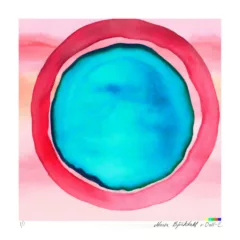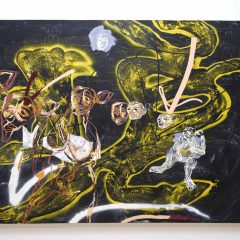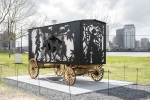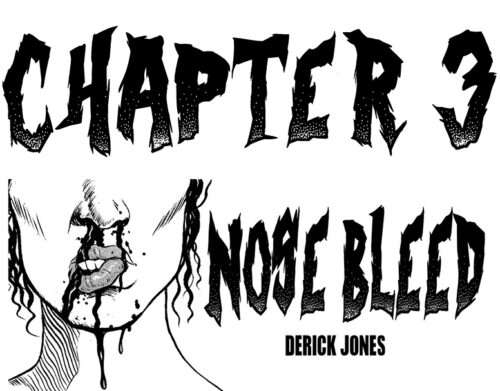Science and art are two of humanity’s most empowering pursuits. Scientific inquiry and artistic expression have a sizable crossover, which lies somewhere within the territories of the imagination and the unending pursuit of the new. Pterodactyl‘s “Intersection” curated by Keith Hartwig resides in that wily middle territory. Whether seekers are after further understanding of physics or new forms and methods, the process of continued exploration bridges the gap between both creative pursuits. The analysis and rationality of science can occasionally seem at odds with the fantastical or surreal representations of contemporary art, but when the two disciplines overlap the result is all the more alluring.
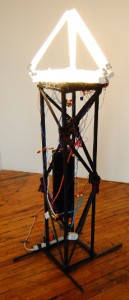
Sacred geometry
Nowhere is this clearer than in Tyler Kline’s “Tetrahedral.” A four-sided, triangle-faced form rests on a black, metal pedestal, wires winding and weaving down through the support’s framework. Each ballast of three fluorescent tubes comprises one edge of the tetrahedron, with the individual sections linked to motion sensors. This piece highlights a variety of scientific and mathematical concepts including the forms of platonic solids, the flow of light energy, and the mechanics of electronic components. There is no doubt that the exploration of sacred geometry stands with one foot firmly in the field of aesthetics and one in empiricism. Kline’s sculpture encourages – or rather requires – visitors to stride entirely around the column. It is fairly common knowledge that in observing three-dimensional artwork, it’s best if the viewer can scrutinize the object from all sides, and here the process is a requisite.
Like a scientist working from all quantifiable data, the art lover must often be equally open-minded, present, and analytical.
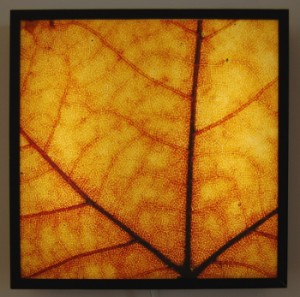
Fractal patterns
Brittany Demilio turns her eye to the interconnectedness of all things by way of fractals, the patterns in much of life – and non-life – that resemble each other on small and large scales. One can trace these connections in many places like the spirals of shells and galaxies or the fanning shapes of tree branches. Their presence links each iteration not just to tinier and greater versions of itself, but to the universe at large. Demilio utilizes high-resolution scans of leaves displayed in light boxes to demonstrate the expanding and complex landscapes of these veined sun-catchers. Not only do we see the environment through one of its finest self-reflective structures, but we are also reminded of similar human technologies like solar panels. While we struggle with energy solutions for the future of a warming planet, it is most wise to keep nature in the forefront of our minds.
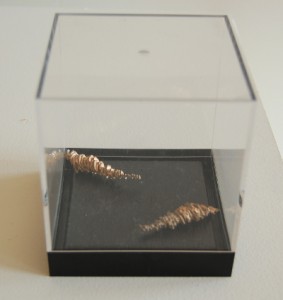
Optics, blind spots and melting bronze via a solar furnace
The area of the retina where the optic nerve attaches to the eye produces blind spots in our field of vision, but we are typically not aware of these discrepancies due to our brain’s ability to adjust for them. Bradley Pitts set out with pencil and paper to trace these regions in order to bring them to our attention. With the help of the solar furnace in Mont-Louis, France, concentrated sunlight was used to melt bronze into molds of the artist’s blind spots. These surreal metallic forms, although minute, ultimately represent the energy and chemical processes used to create them – the sun which bestows us all with life, our shared biology, and even our imperfections and weaknesses, both as individuals and a species.
Micro- and Macro-ecosystems
A pair of videos by Erin Espelie entitled “Beyond Expression Bright” and “Silent Springs” examines the range of scientific inquiry from the miniscule – the focus of microscopes and footage of dusty old slides, images of toads and inchworms, and talk of subatomic particles – to the immense – the effects of chemicals in the ecosystem at large, as well as the vast reaches of the universe and the surfaces of distant planets. These montages draw on many voices from the scientific community and lay out a spread of content that shows just how expansive human curiosity can be.
Other artists in the show include Alexis Kandra, Allison Lutz, Kelsey Halliday Johnson, and Kristin Grey Apple. If ever there were a doubt that science and art could be wonderful bedfellows, the creators and investigators in “Intersection” pull this relationship into the spotlight for a study that marries the ‘left’ and ‘right’ sides of the brain in collaborative harmony. The exhibit will be up through July 6.



